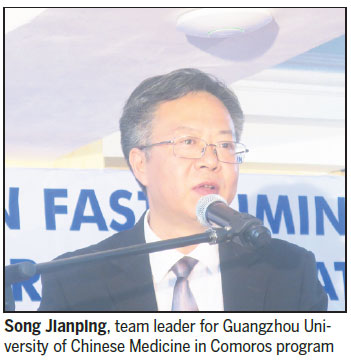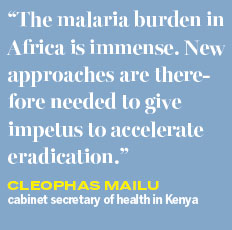Taking malaria fight to the source
Chinese researchers hope to replicate their Comoros success in East and Central Africa
After successfully pushing malaria to the brink of elimination in the Comoros, an archipelago nation off Africa's east coast, Chinese researchers have set their sights on East and Central Africa, where they hope to replicate their success.
They are proposing the administration of antimalarial drugs to a large population in a strategy that would re-energize the war against malaria in an approach known as mass drug administration - an intervention used for more than 70 years to control the spread of the deadly disease.
The researchers from Guangzhou University of Chinese Medicine say the artemisinin-based drug combination stops the parasitic cycle of reproducing and multiplying in human cells. Known as Artequick, the fixed dose of artemisinin and piperaquine has had successful trials in China, Vietnam, Cambodia, Indonesia and the Comoros.
|
Cleophas Mailu, cabinet secretary of health in Kenya, says the country needs to pursue alternative approaches to further strengthen the campaign against the disease. Photos by Lucie Morangi |
The researchers met with senior government officials from Kenya's Ministry of Health on April 21 to discuss cooperation on this front.
The event also saw government representatives from Malawi and Togo, who are at different stages of implementing a program known as Fast Elimination of Malaria by Source Eradication. References were made at the event to the success of the program in Comoros.
Song Jianping, the leader of the Chinese team in the Comoros, says that from the onset, the project received strong government support, making it easy to mobilize resources and get a population profile. A baseline study launched in 2006 determined that the rate of prevalence was 80 percent. Malaria was also the leading cause of morbidity and mortality, especially in children under age 5.
The country consists of four islands with a population of less than 1 million. The Sino-Comoran anti-malaria project was implemented on the three islands of Moheli, Anjouan and Grande Comore. Over 2.2 million people enrolled to participate in the treatment.

By 2014, Comoros achieved zero malaria deaths. Cases fell by 98 percent since 2008, and the rate of malaria was reduced to 2.8 per 1,000 population, from 142 per 1,000.
"The malaria-free program offered by China has had great success and provides Africa with a new way to rapidly control malaria," says Song.
The World Health Organization lists malaria as a life-threatening disease. In a report released in December, the WHO said there were 212 million new cases of malaria worldwide in 2015.The WHO's African region accounted for most global cases, at 90 percent, followed by the Southeast Asia region, 7 percent, and the eastern Mediterranean, 2 percent.
That same year, there were an estimated 429,000 malaria deaths worldwide, the report said. Most of the deaths occurred in Africa, with 92 percent, followed by Southeast Asia, 6 percent, and the eastern Mediterranean, 2 percent, the report said.
Although Kenya is implementing a nationwide malaria strategy, it is still struggling to eliminate the disease. In 2010, it recorded 30 percent of outpatient visits to hospitals being related to malaria; the figure has since dropped to 11 percent. Epidemics are usually reported during rainy seasons.
Cleophas Mailu, the country's cabinet secretary of health, says the country's cost for implementing the malaria strategy is about $150 million (133 million euros; £115 million) per year. The budgetary allocation for the ministry this year was about 7 percent, much lower than sought by the Abuja Declaration - in which African Union countries set a target in 2001 of allocating 15 percent of annual budgets to the health sector - thus hampering efforts to strengthen health systems and enhance surveillance.
"The malaria burden in Africa is immense. Its impact is seen in absenteeism from work or school (and it) heavily dents household expenditure and affects the country's productivity. New approaches are therefore needed to give impetus to accelerate eradication," says Mailu.
He notes that Kenya continues to strongly implement preventive strategies, widely distributing long-lasting mosquito nets and indoor residual spray, improving public awareness of the disease and urging prompt medical care at the onset of symptoms. The use of artemisinin combination therapy was also adopted as firstline treatment in 2006.
"We have been able to control the vectorborne disease, but it is time to eradicate it," he says.
Affane Bacar, the director of the the Comoros' National Malaria Control Program, says the efficacy of this approach is low, so there is a need to step up the fight using mass drug administration.
"We had to rethink our approach and be more innovative. The most effective way was to eliminate the infection at the source," says Bacar.
The mass administration of Artequick was therefore welcome in the Comoros, Bacar says. But systems had to be established to manage the new approach, and "266 medical personnel were trained and equipped to offer services from personal to mass treatment," he adds.

Bacar says that mass drug administration eventually reduced the costs of the disease, since it was time-consuming and costly to search for cases and treat them in addition to conducting testing in the villages.
On the island of Moheli, which has a population of 40,000, the mass drug administration campaign was launched in 2007. The rate of prevalence dropped from 23 percent to 0.03 percent. "In 110 days, the infection incidences were reduced by 98 percent. This gave the campaign the necessary impetus to scale it to the other three islands," says Bacar.
The success of the campaign is evident, he adds. "There has been a drastic fall in household expenditure toward the treatment of malaria, thus leaving them with more disposable income. Productivity has gone up, and school attendance and performance is remarkable. I believe that fighting the epdemic disease is an important factor toward reduction of poverty," says the Comoros malaria program director.
He attributes the success to government support. "Public involvement was the underlying factor that pushed the success of the program. We have also proved that mass treatment is less costly than other approaches, since the efficacy is rapid," says Bacar.
The government program was also able to manage resources well and reinforced the health system, in contrast with other countries that suffered from the pressures of deadly pandemics such as Ebola in West Africa, he adds.
"We, however, closed these gaps. But we still need adequate financing to strengthen the surveillance systems to ensure that we keep malaria at bay. This program has also reinforced dialogue in the country."
The success has earned admiration in other countries. Malawi, a central African country with a population of about 17 million people, is looking at reducing the prevalence of malaria. At least 6 million cases were reported in the country last year.
"Our challenges are case management, capacity of medical personnel and easy access to drugs," says Michael Kayange, the deputy director of Preventive Health Services in Malawi's Ministry of Health.
"With an only 20 percent reduction rate in 20 years, we have to come up with an alternative yet effective strategy," he says. "Our target is to reduce the prevalence by 50 percent and morbidity by the same margins in the next six years."
Malawi has launched a major research facility for the mass drug administration program, and an agreement has been signed with Guangzhou University of Chinese Medicine. He says the program will be implemented alongside the country's ongoing malaria vaccine pilot program.
Togo, on the other hand, has already rolled out the first round of drug administration and is about to embark on the second. The challenge is on surveillance due to the long and porous borders that increase free movement of people with neighboring Benin and Burkina Faso.
Wang Guoqiang, vice-director of China's National Health and Family Planning Commission and director of the State Administration of Traditional Chinese Medicine of China, says the most important thing is to control the permanent population first. "In China, this is a challenge we also faced. But we ensured that we eliminated the parasite from residents living in highly endemic areas first, then strengthened border checks, where people receive the drugs at point of entry. "
East African governments have shown interest in pursuing the program. Fears of an influx of fake drugs have previously weakened the fight against the disease. This is especially serious in Tanzania and Uganda, which together accounted for 20 million of the 94 million cases reported globally in 2010.
lucymorangi@chinadaily.com.cn
(China Daily Africa Weekly 05/26/2017 page22)





















